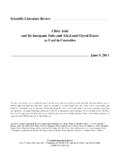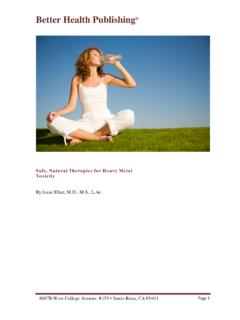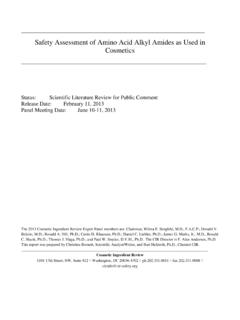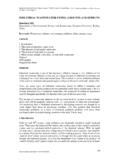Transcription of Final Report of the Cosmetic Ingredient Review …
1 1 Final Report of the Cosmetic Ingredient Review Expert Panel On the Safety Assessment of 1,2-Glycols as Used in cosmetics June 28, 2011 The 2011 Cosmetic Ingredient Review Expert Panel members are: Chairman, Wilma F. Bergfeld, , ; Donald V. Belsito, ; Ronald A. Hill, ; Curtis D. Klaassen, ; Daniel C. Liebler, ; James G. Marks, Jr., , Ronald C. Shank, ; Thomas J. Slaga, ; and Paul W. Snyder, , The CIR Director is F. Alan Andersen, This Report was prepared by Wilbur Johnson, Jr., , Manager/Lead Specialist. Co s m e t i c I n g r e d i e n t R e v i e w 1101 17th Street, NW, Suite 412 Washington, DC 20036-4702 (202) 331-0651 fax ABSTRACT: Caprylyl glycol and related 1,2-glycols are used mostly as skin and hair conditioning agents and viscosity agents in Cosmetic products, and caprylyl glycol and pentylene glycol also function as Cosmetic preservatives.
2 The Expert Panel noted that these ingredients are dermally absorbed and that modeling data predict decreased skin penetration of longer-chain 1,2-glycols. The Panel concluded that negative oral toxicity data on shorter-chain 1,2-glycols and genotoxicity data support the safety of all of the 1,2-glycols reviewed in this safety assessment. Thus, it was concluded that these ingredients are safe in the present practices of use and concentration described in this safety assessment. INTRODUCTION This Report assesses the safety of 1,2-glycols, as used in Cosmetic products. The 1,2-glycols are used mostly as skin and hair conditioning agents and viscosity increasing agents in these products, and caprylyl glycol and pentylene glycol are also used as preservatives. This safety assessment includes the following 1,2-glycols : caprylyl glycol arachidyl glycol cetyl glycol hexacosyl glycol lauryl glycol myristyl glycol octacosanyl glycol stearyl glycol decylene glycol pentylene glycol 1,2-butanediol 1,2-hexanediol C14-18 glycol C15-18 glycol C18-30 glycol C20-30 glycol Of the 16 ingredients that are being reviewed in this safety assessment, 5 are being used in personal care products: caprylyl glycol, pentylene glycol, 1,2-hexanediol, and C15-18 glycol.
3 The remaining 12 ingredients are not reported to be in current use. A CIR Final safety assessment on propylene glycol (PG), short-chain 1,2-glycol, and polypropylene glycols was published in ,1 The CIR Expert Panel concluded that PG and polypropylene glycols are safe for use in Cosmetic products at concentrations up to At its June 28-29, 2010 meeting, the Expert Panel issued an amended Final safety assessment on propylene glycol, tripropylene glycol, and polypropylene glycols with the following conclusion: The CIR Expert Panel concluded that propylene glycol, tripropylene glycol, PPG-3, -7, -9, -12, -13, -15, -16, -17, -20, -26, -30, -33, -34, -51, -52, -69, and any PPG 3, are safe as Cosmetic ingredients in the present practices of use and concentration as described in this safety assessment when formulated to be In the absence of safety test data on many of the 1,2-glycols reviewed in this safety assessment, data on PG from both the CIR published Final safety assessment and amended Final safety assessment are included to support the safety of these ingredients in personal care products.
4 CHEMISTRY Definition and Structure Other chemical names and Cosmetic Ingredient functions for the ingredients reviewed in this safety assessment are included in Table Caprylyl glycol and other 1,2-glycols are generally defined as the compounds that conform to a structure or formula. The fundamental carbon backbone contains a hydroxyl group at the 1 and 2 positions, and the length of the carbon backbone varies from one structure to another. Chemical structures for the 1,2-glycols that are being reviewed are included in Figure 1. Chemical and Physical Properties Available data on the properties of the following ingredients are included in Table 2: caprylyl glycol, arachidyl glycol, cetyl glycol, lauryl glycol, myristyl glycol, octacosanyl glycol, stearyl glycol, decylene glycol, pentylene glycol, 1,2-butanediol, and 1,2-hexanediol. The solubility of these ingredients in water ranges from highly soluble (1,2-butanediol, octanol/water partition coefficient of ) to poorly soluble (octacosanyl glycol, octanol/water partition coefficient of approximately ).
5 No information on the chemical and physical properties of C14-18, C15-18, C18-30, and C20-30 glycols were found, but because these ingredients are mixtures of various length glycols, their chemical and physical properties are expected to reflect their individual components. Methods of Production The commercially practiced synthesis of ethylene glycol, the simplest of the 1,2-glycols, commonly occurs via a thermal oxidation of ethylene oxide with The commercial production of other 1,2-glycols, including those currently under Review herein, are commonly synthesized via either catalytic oxidation of the corresponding alkene oxide, or reduction of the corresponding 2-hydroxy acid. C15-18 glycol, for example, has been prepared via oxidation of the corresponding C15-C18 1,2-alkylene oxides (and the 1,2-alkylene oxides have been synthesized via epoxidation of the corresponding 1,2-alkenes).
6 5 Stearyl glycol has been prepared via the reduction of 2-hydroxyoctadecanoic acid with lithium aluminum This reaction is followed by the quenching of any unchanged lithium aluminum hydride with excess ethyl acetate, filtering of salt, and subsequent drying of the resulting solution. The production of 1,2-butanediol, much like the synthesis of ethylene glycol, is commonly carried out via a continuous reaction and distillation operation. 7 Composition/Impurities The heavy metals specification for > 98% caprylyl glycol (Dermosoft Octiol) is 5 ppm max (as Pb).8 Decylene glycol (as SymClariol ) contains 98% to 100% decylene 1,2-Butanediol is 99% pure and also contains water, 1,4-butanediol, and Analytical Methods Cetyl glycol has been analyzed using silica gel thin-layer chromatography, and has been identified using IR and mass ,11 Decylene glycol has been analyzed via gas chromatography, and has been identified using mass, IR, and NMR spectroscopy.
7 11, 12 Gas chromatography-mass spectrometry (GC-MS) has been used in the analysis of stearyl Lauryl glycol, myristyl glycol, caprylyl glycol, pentylene glycol, 1,2-butanediol, and 1,2-hexanediol have been identified using mass spectrometry and IR or NMR spectroscopy. 11 UV absorption data on caprylyl glycol or any of the other 1,2-glycols reviewed in this safety assessment were not provided or found in the published literature. Based on the chemical formulas included in Figure 1, there is no reason to suspect that any UV absorption would be associated with these 1,2-glycols. Reactivity For 1,2-butanediol at temperatures above 90 C, explosive vapor/air mixtures may be Additional information on the reactivity of 1,2-butanediol, in relation to the EPA-proposed national rule on the reduction of ozone formation, is included in the section on Noncosmetic Use later in the Report text.
8 USE Purpose in cosmetics Most of the ingredients reviewed in this safety assessment function as skin and hair conditioning agents and viscosity increasing agents in personal care Scope and Extent Of Use in cosmetics According to information supplied by industry as part of the Voluntary Cosmetic Registration Program (VCRP), obtained from the Food and Drug Administration (FDA) in 2011, the following ingredients were being used in personal care products: caprylyl glycol, decylene glycol, pentylene glycol, 1,2-hexanediol, and C15-18 These data are summarized in Table 3. Independent of these data, the results of a survey of Ingredient use concentrations that was conducted by the Personal Care Products Council in 2010, also in Table 3, indicate that three 1,2-glycols were being used at the following concentrations: caprylyl glycol ( to 5%), pentylene glycol ( to 5%), and 1,2-hexanediol ( to 10%).
9 15 According to FDA s VCRP data, there was no indication that the following remaining ingredients in this safety assessment were being used in Cosmetic products in 2011: arachidyl glycol, cetyl glycol, hexacosyl glycol, lauryl glycol, myristyl glycol, octacosanyl glycol, stearyl glycol, 1,2-butanediol, C14-18 glycol, C18-30 glycol, and C20-30 glycol. Personal care products containing these ingredients may be applied to the skin, nails, or hair, or, incidentally, may come in contact with eyes and mucous membranes. Products containing these ingredients may be applied as frequently as several times per day and may come in contact with the skin, nails, or hair for variable periods following application. Daily or occasional use may extend over many years. Noncosmetic Use Caprylyl Glycol Study results support the notion that treatment of glutaraldehyde-treated tissue with a short-chain alcohol (ethanolic buffered solution) and long-chain alcohol (caprylyl glycol) combination will reduce both extractable phospholipids and the propensity for in vivo calcification.
10 The use of glutaraldehyde-treated biological tissue in heart valve substitutes is an important option in the treatment of heart valve disease; however, the durability of these devices is limited, in part, because of tissue 1,2-Butanediol The Environmental Protection Agency (EPA) lists 1,2-Butanediol as one of the reactive compounds in aerosol coatings ( , aerosol spray paints) that contributes to ozone (O3) formation. It is listed as having a reactivity factor of g O3/g 1,2-butanediol. Reactivity factor is defined as a measure of the change in mass of ozone formed by adding a gram of a volatile organic compound (VOC) to the ambient atmosphere. This listing of compounds, such as 1,2-butanediol, is in keeping with the EPA proposal to amend the aerosol coatings reactivity rule by adding compounds and associated reactivity factors based on petitions that were received. The EPA has concluded that a national rule based on the relative reactivity approach achieves more reduction in ozone formation than would be achieved by a mass-based approach for this specific product category.




